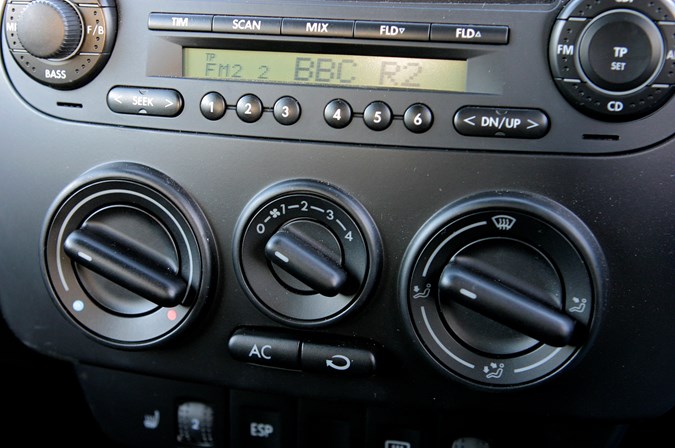When buying a used car, it’s easy to focus on the obvious areas like paintwork, wheels and tyres or how it drives while overlooking expensive technology such as air conditioning.
Being sure that all of the equipment is working, from safety to fun gadgets, can be tricky without a model-specific checklist. However, of all the technology you’re likely to find in a modern used car air conditioning is the most common, consistenly laid-out and desirable feature.
It’s also one of the most likely to have been neglected.
Air conditioning or climate control?
Older and lower-cost cars are likely to have straightforward air con, or ‘manual air conditioning’.
Cooling the air that comes into the car, it allows a lower temperature to be achieved than just with fresh air and fans alone, and has become more popular as car heating systems have become more sophisticated, with less direct routes for outside air to enter the cabin.
You’ll often find niceties like a pollen filter, and the way air-con works also allows faster demisting by condensing moisture from the cabin and draining it outside. This is why so many cars with air con leave a puddle of clean water behind in summer, and rather than being a leak or a sign of problems, it indicates a healthy and effective air conditioning system.
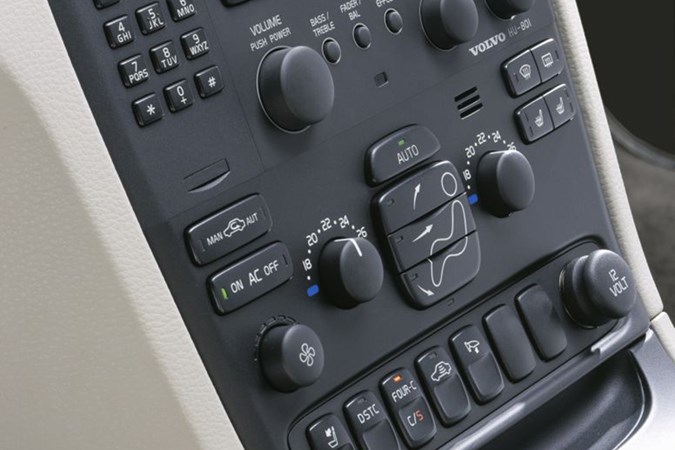
Greater sophistication comes in the form of climate control, where the driver can set a temperature on the heater controls, and the car will take car of fan speed, distribution and hot/cold air flow to maintain the same level of warmth in the cabin.
This is further improved on the most recent, and older luxury cars, by the addition of zones. Providing individual temperature control for the driver and passenger sides of the car, dual-zone is the most common arrangement. Many MPVs and SUVs also offer three-zone climate control, giving the rear occupants their own environment.
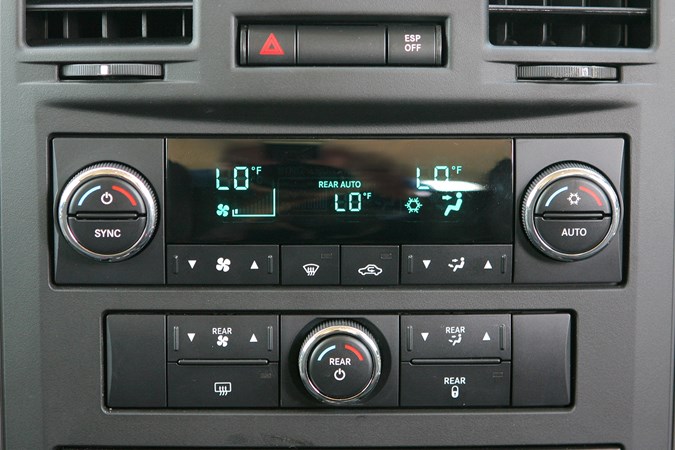
Although climate control is more sophisticated than air conditioning, the basics of cooling the air coming into the car are the same. The clever bit of maintaining a temperature, and choosing when to recirculate air to minimise pollution or speed up warming or cooling is generally handled by a computer; these modules are expensive but as a rule, very reliable.
How does air conditioning work?
Fundamentally, air conditioning is a fridge in your car; an engine-driven compressor pumps refrigerant through a drier, condenser at the front of the car – usually mounted ahead of the radiator – and an evaporator in the same rough location as the fan, heater matrix and vents that direct the air to face, feet or windscreen.
These major components are all potential points of failure that can cost a significant amount to repair, particularly if the car has sophisticated or luxury interior trim, a tightly-packed engine bay or is known for expensive parts. Before all of these can be considered there has to be a supply of refrigerant in the system.
If no pressure is detected, then the nothing else will work in order to protect the components. Some cars also disable the air conditioning in freezing temperatures, to prevent icing of vulnerable parts.
Testing the air con on a used car – stay cool!
How effective a climate control system is can vary between cars, but there’s a rule of thumb that effective air con can reduce the temperature at the vents by 9 to 18 degrees centigrade. You can test this with special thermometers, from affordable clip-on vent types that have probes to sophisticated digital models, or you can go full hipster with a vintage glass mercury type if you really want to.
Once the car is warmed-up, and with the engine running, set the temperature controls to minimum (either all the way into the blue, the lowest number on the dial, or ‘LO’ on most digital displays) with the air conditioning off. That’s either going to be an AC on/off button, or a picture of a snowflake within the heater controls.
Measure the temperature with the fans on half-speed, directed to the face-level vents. It will generally be a little colder, but not much, than the ambient temperature outside. If a car has climate control, it will set the fans to maximum unless you override them.
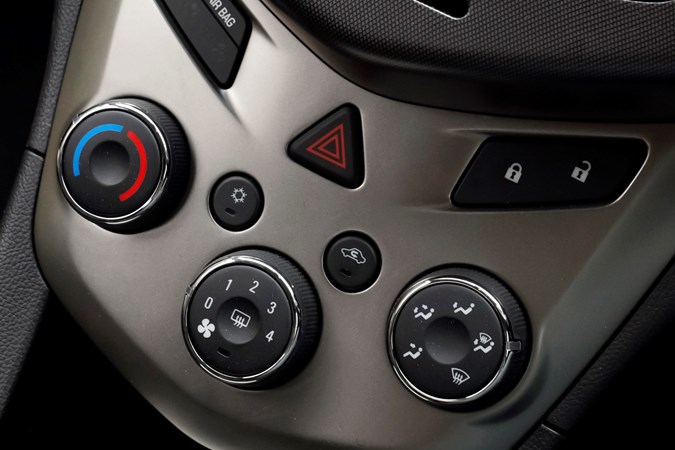
Now switch the air conditioning on, keeping the thermometer in the same place. You should hear some new noises; a slight clunk or click, the radiator fan if not already running, and sometimes a motor inside the dashboard. The revs on the car may drop slightly, then rise again; if they don’t return to the proper idle speed, that indicates a fault. Some older cars will only cool effectively when the engine is at working speeds, rather than idling, so raise the RPM to about 1,500 if It sounds like all the other stages have happened, but the vents are still warm.
The air from the vents should get perceptibly colder. The phrase ‘ice-cold AC’ is apt for a properly healthy system!
If it doesn’t work, it could be that the air con needs to be recharged, sometimes an affordable fix, or it could be an indicator of a much bigger problem. Unless the car you’re looking at is particularly rare or cheap, we’d recommend asking the seller to have the AC checked by a specialist, and coming back after they’ve done so; it should cost them less than an MOT to get an idea of how healthy the air con is.
Why does air conditioning need to be recharged?
Replacing or topping the refrigerant up is often referred to as recharging the air-con, and it can be done relatively cheaply on most cars sold after 1995. Over time, there have been several types of gas and lubricant used in car air con systems, naturally moving to more environmentally-friendly solutions in line with other automotive technologies. It shouldn’t leak, but it does so naturally over time and even a healthy three-year old car is likely to have a less-efficient air con system than when new. You should replace this regularly anyway, as it also carries the lubricant for the compressor.
Older cars can still be recharged, but with more effort. If you’re considering a car made before 1993, it’s highly likely to have used the older R12, Freon-based refrigerant. This can be sourced by specialists, replaced with a special blend called R143a which is less effective, but doesn’t damage the seals, or the air con can be converted to easily-optained R134a by replacing most of the seals, the connections and sometimes, major components.
Neglected AC systems can develop odours from damp, so periodic cleaning can be worthwhile.
Save money by checking climate control properly
Once you’ve established the air conditioner is working on the car, make sure that everything else is up to spec. Run through the temperature range – the fan should slow down when the desired setting is close to the car’s ambient temp, and then speed up to heat or cool as you move to the extremes. Give it time to respond, as some cars are designed to be quiet by not constantly trying to adjust ventilation.
If dual zone is installed, set one side to maximum heat, and the other to the coldest, then check the vents. You’ll feel it with your hand, but if you want to measure it around 10 degrees difference per side is acceptable; the vents should show a greater range. Cycle through the vent positions and fan speeds, and check demisting works too.
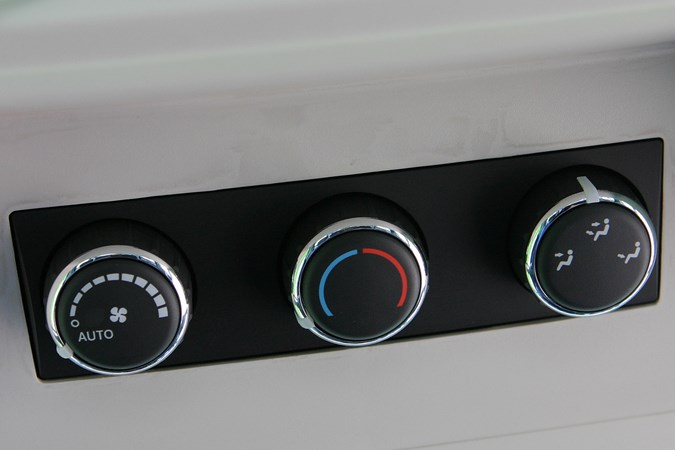
Don’t neglect the rear controls on three-zone systems, as there are components under the car that are vulnerable – and expensive to repair – on many MPVs and SUVs.
If the fan doesn’t operate at all speed settings, buttons don’t respond, displays aren’t illuminated or showing all the segments they should, then be prepared for at least £200 in repair and diagnostic costs. If there are clunking or grinding noises, or the airflow doesn’t move even if the settings show as being changed, then fixing the climate control could run into thousands of pounds.
Common car air-con cons – and failures to look for
- There’s a sight glass on top of the AC receiver/drier. If the system is working, you’ll see bubbles in it
- Don’t be fooled by ‘it just needs a recharge’ – the gas has to have escaped somehow
- Inspect the AC pipes under the bonnet to make sure the pressure caps are in place – if they’re missing, the seller might have been trying to cover up an issue
- Feel the AC pipes when the engine is running, too – they get very cold if the system is working
- Cheap top-up cans don’t last, so if the seller says they’ve recharged the AC, ask how
- If you can, look at the belts with the engine running. The flat circular clutch on the AC compressor will stay still unless the air con is running, and should engage and spin with no more than a gentle click
- Inspect the radiators at the front of the car, and underneath if you have access. You can usually follow the AC pipes to the condenser, and look for oily residue, torn or damaged fins, and corrosion
- If you have a UV – ultraviolet or blacklight – torch, then you can look for signs of leaking
- If the AC isn’t working, it’s worth checking that fuses haven’t been removed to hide a bigger issue such as a seized compressor
- Don’t be alarmed if odourless vapor escapes the vents on a humid day – sometimes the components can ice up, particularly on convertible cars that may get damp inside
- Do look for the tell-tale puddle of condensation under the car. If the drain is blocked, that condensation can end up in the footwells instead
- If there’s a sweet smell from the vents, faint sticky grease on the windscreen, or a slight tackiness to the front carpets the heater matrix might be leaking, which not only affects the climate control system, it can lead to coolant loss and overheating of the engine too – and is often very expensive to replace
Costs of getting the air-con fixed on a second-hand car
Most main-dealer garages will be able to repair a modern air conditioning system, but specialists can be cheaper if your car is out of warranty, and smaller firms may outsource AC work anyway. Even so, components can be quite expensive – particularly the compressor and vulnerable condenser, as well as electronic control units – and those that aren’t so pricey may still involve hours of labour to strip down and replace large amounts of trim around the interior and dashboard.
We’d recommend buying a used car warranty if the car you’ve chosen is less than ten years old, or is a particularly upmarket model. For older and simpler cars, look for air conditioning specialists for problems with the condenser, compressor, receiver/drier, engine compartment pipework, and on MPVs like the Chrysler Voyager, rear heating and cooling.
To ensure interior trim and electronics are handled with expert knowledge of what is clipped where, repairs to the vents, temperature controls and evaporator are best handled by main dealers or marque specialists.
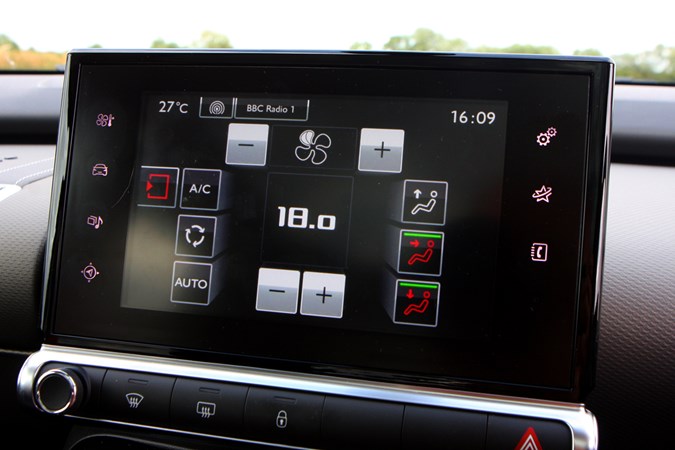
Control panels can often be removed and repaired easily by firms like BBA Reman, but you’ll want to be sure that the fault lies in the ECU and not with a sensor or component elsewhere. On some Peugeot and Citroen models with touch-screen heater controls, there’s no backup; more recent models have returned to buttons for vital features.
DIY air conditioning repairs
Feeling brave? On the whole, it’s best not to mess with air conditioning, as the pressurised gas is quite harmful to the environment and, indeed, to the mechanic if not handled correctly. If you suspect a car has a slight leak, there are affordable recharge canisters available from high-street motor spares shops like Halfords; these may work for a short period, but if you suspect there’s a fault you’re better off taking the car to Kwik-Fit or similar. These garages will typically charge around £50 for a vacuum, pressure test and recharge, and if the system is leaking you may not get charged, and will be told where the fault lies as they use ultraviolet dyes to identify leaks.
Repairing a depressurised system for common faults, like receiver/drier replacement, cleaning and repairing switches, or swapping over the compressor, is no harder than other cooling/heating system tasks, but you’ll still need the right gear to refill and test your work.
Buying a car with broken air con
Is it worth taking on a car if the AC doesn’t work? You’ll find ventilation is less effective than a car that didn’t have air-con in the first place, and some mechanical repairs will be more involved. Demisting will be particularly difficult, and you may get more condensation in the cabin too. Finally, you may want to bypass the belts for damaged parts like the compressor as they can increase strain on the engine.
If you really want that specific car, we’d recommend taking it to a mechanic familiar with the model so you can get a clear idea of how much less it should cost than a good one.
